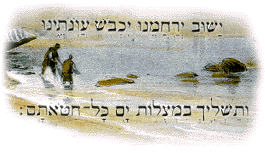
After
the lines from Micah and some additional prayers composed in more recent
years, it is customary to shake the skirt of one's garments over the water
or to empty one's pockets, as if physically transferring one's sins to
the river or ocean, so that they might be carried out and forgotten. This
ceremony is known as
Tashlikh ("you shall cast" in Hebrew).
The seashore, a river or flowing brook, or even a well of spring water,
may serve the purpose, but not a pool or any stagnant water. The later
rabbis required that the water should have fish, which serve the purpose
of reminding us that we are like the fish caught in the net — weak,
helpless, and subject to the many ills that beset us in life.
The symbolic nature of the ceremony is quite obvious. The consciousness
of sin and the regret for the commission of sins become very keen on the
Day of Remembrance (another name for Rosh Hashanah). One hopes and prays
that in deciding his fate for the coming year, God will overlook his shortcomings
and failings during the past year. By sending his sins away on the bosom
of the ocean or the flowing stream, he figuratively expresses his desire
that they might disappear from the sight of God and might not serve as
a deterrent in the way of his gaining the favor of Providence.
We find occasional references in the bible to the custom of holding prayer meetings
at the waterside, and these references are multiplied in post-biblical literature.
According to Philo,
[2]
the shore of the river is the most appropriate spot for prayer, since this is
the "purest place." Josephus
[3]
quotes a decree which permitted the Jews f Halicarnassus "to have their
places of prayer by the seaside, according to the custom of their forefathers."
More pointed is the remark found in the Zohar, a kabbalistic work of the thirteenth
century, which says that "whatever falls into the deep is lost forever;
it acts like the scapegoat for the absolution of sins."
It is doubtful, however, whether the custom of
Tashlikh existed before
the fourteenth century, as there is no mention of it in the Talmud or in any
of the subsequent works to the time. It is first mentioned in the work of German
rabbi Jacob Molin
[4]
who lived in the late fourteenth century. In his compilation of the customs
of his generation and his land, Jacob Molin mentions the custom of
Tashlikh
and refers to the midrashic legend concerning the attempted sacrifice of Isaac.
According to the legend, Satan, intent on thwarting Abraham's plan to follow
the command of God and sacrifice his son, placed himself in front of Abraham
in the form of a deep stream. Abraham and Isaac nevertheless plunged into the
river and prayed for aid, whereupon the scream disappeared. While the sacrifice
of Isaac is frequently alluded to in the prayers for Rosh Hashanah, the connection
of
Tashlikh with this legend seems far-fetched. Nor are the various explanations
offered by later authorities more convincing.
Different communities introduced variations in the ritual, and many kabbalistic
additions were made, especially among Eastern Jews; for example, in the
added prayers arranged for the occasion, reference is made to the evil
spirits (kelippot) created by the sins of the individual, which cling
to one's garments and which should be shaken from them into the water.
The custom of casting small pieces of bread upon the waters as food for
the fish is already mentioned by Molin, who strove to discourage it. It
was mainly due to the mystical elements added to the ceremony that many
have opposed its practice, while others have tried to find in it traces
of heathen superstitions. For most observant Jews, however, Tashlikh remains
a purely symbolic act, emphasizing concretely the yearning to be cleared
of sin and the hope that one may be forgiven.



